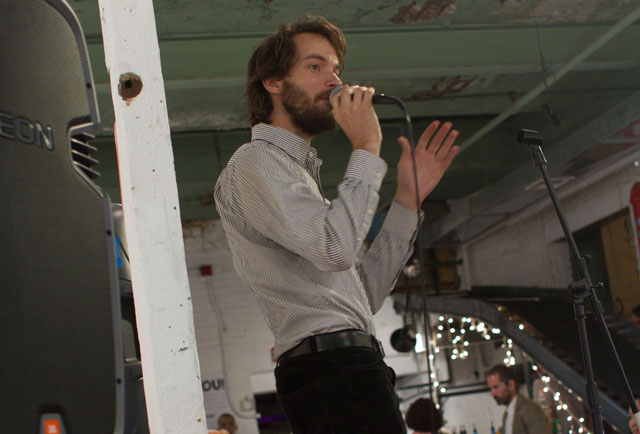Ever notice how all of those alternative spaces don’t look all that different from the establishment? Flux Factory’s residency is different. Creativity seems to drip from the walls: there’s a doorbell that rings in the bathroom, a disco ball and a chicken hang from kitchen ceiling, and the studios are often coated in art. No other space in New York looks like this.
So, when I heard that Nat Roe (of Silent Barn) would be taking over the role of executive director from Christina Vassallo, I wanted to see what kinds of plans he had in store. Would the disco ball remain? Would the doorbell still function?
When I asked Roe what was in store for the residency, change didn’t seem high on the list; still, I tried to find out what day in the life of an executive director at Flux looked like. “I have three words. Emails. Meetings. Spreadsheets,” Roe told me over email. “All day. Every day!” I was disappointed to hear that he wasn’t chasing down more plastic chickens for the kitchen; turns out, even the most anti-establishment organizations have to deal with administration. None of that sounds very exciting, and one gets the sense it’s sometimes a struggle. Roe tells me the transition to a non-profit financial model was a bit “surreal.” Dealing with the books is a complicated task, and one he needs an assistant to help manage. Currently, Flux has a position opening up for a new administrator and bookkeeper.
All this may seem tedious, but thankfully it’s not the only kind of work that gets done. Due to Roe’s background at Silent Barn, the collaborative environment at Flux feels familiar—residents eat dinner together nearly every night, and this collective works because “everybody gives so much of themselves to Flux”.
That so many people care so deeply about Flux makes its future seem bright, even if it is, ultimately, unknowable. “Now I have my own personal opinions on our long-term path,” Roe told me, “but as a director I will put a strong emphasis on something I find essential to Flux: facilitation of our collective’s diverse viewpoints.” Apparently this means looking to the past first. Flux is celebrating their 20 years of existence with their Homecoming exhibition, (viewable this Sunday 12:00 p.m. – 6:00 p.m. and then again for Flux Thursday on August 14th at 8:00 p.m.) which will include a look at their vast archives. We’ve been promised “Kissing Booth Secret Tapes” and a long-lost holographic family portrait. All this should be a perfect starting point for “Flux in 2034,” a brainstorming session in conjunction with their next exhibition about what Flux Factory is, and can be, to launch in October. “Hoverboards will fit in the picture somehow,” Roe tells me.
Roe’s playfulness reminded me of why Flux is so important to city. It’s one of the few places in the city that lacks the kind of performative art-making culture I find stifling; it’s painfully self-conscious. Certainly it takes all the spontaneity and fun out of art-making. “Fluxiness,” a term those at the residency use to describe the loose and accessible creative spirit driving their work, seemed implicit in Roe’s commentary, so I asked him whether he thought a director could be fluxy. “I’d say that’s tied up in our facilitation role,” he replied. “Collectivism is a truly unwieldy experiment—a diverse group of peers collaborating on a deep level is never efficient and we mess up frequently. We do things that aren’t as slick as what you’d get from an individually directed project. But, ultimately, I am convinced that because of all this chaos, collectives are in a singular position to embody the best aspects of the creative life, and perform a much needed civic task for New York City.”
Exactly what is that civic task? Roe laments how the art world is tethered to social elitism, but sees the medium itself as an opportunity to break down those barriers. “Art collectives are particularly good for social healing, since they explicitly put people’s relationships at the forefront of their mission,” he told me. “At places like Flux, you tend to see alternative forms of capital traded. We share and reuse materials. We are supported heavily by volunteerism. We offer free education to the public. I’d say showing the city that you can be rich without dollars is a thing Flux—and art collectives in general—can do best.”



Comments on this entry are closed.